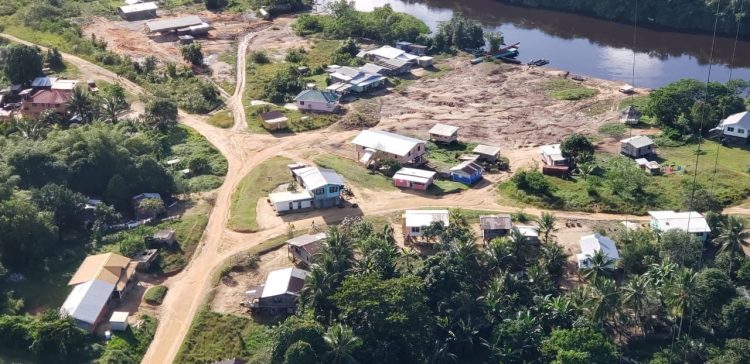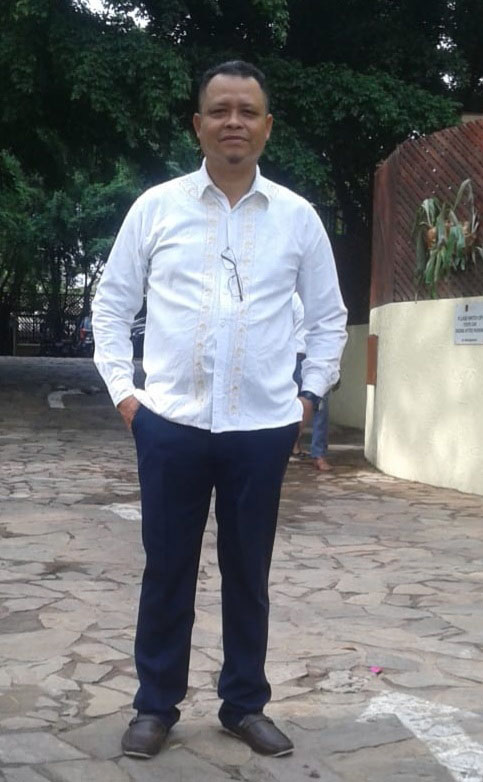Best known as “Toshao” in the village of Kwebanna, on the Waini River, even though he is no longer the office holder, Paul Pierre has given his youth and adult life to community and political activism while he took the path of self-employment to achieve his objective of giving public service to his home in Koriabo and adopted home of Kwebanna.
He was elected to serve on the Regional Democratic Council (RDC), of Region One (Barima-Waini) and, subsequently, as vice chairman of the National Toshaos Council (NTC).
Not at the helm at present, Pierre told Stabroek Weekend in a telephone interview, “I still have the development of Indigenous communities at heart and given the experiences I have had, I can play a big role in advising. I value my contribution in serving not only Kwebanna but the region and country on the whole.”
A farmer and businessman, Pierre who was born in Koriabo River in the Mabaruma sub-region, served as toshao for two and a half terms (five years) from 2001 to 2006, then as vice chairman for Region One RDC and subsequently as regional chairman for the same RDC.

As vice chairman, he was posted to Mabaruma, the administrative centre for Region One, where he spent nine years before returning to Kwebanna to once again be twice elected its toshao. Today, he is a village councillor since he could not be reelected toshao in keeping with the provisions of the Amerindian Act.
Educated at St Mary’s Primary, he was the second person in the river at the time to obtain a hinterland scholarship. He attended Christ Church Secondary School and after successfully completing his secondary education he returned to Koriabo, where instead of seeking an office or clerical job he ventured into part-time farming, logging and mining to maintain a level of independence while helping others in his community.
He moved to Kwebanna in 1992, got married in 1993 and started a family. He has nine children.
In 2001, Pierre, of Warrau ancestry, was elected toshao of Kwebanna, a predominantly Carib community.
“When I first took office as toshao in 2001, I was very inexperienced. The former headmaster of the primary school, former toshaos and church leaders guided me. I had to get acquainted with the people,” he recalled.
At the time, Kwebanna’s economy was in a slump. The community had been dependent on the logging company, A Mazaharally and Sons Ltd for employment. When the logging company pulled out in 1999, the village had to find ways to return its economy to some semblance of stability.
“People wanted to continue logging. I took on the responsibility of looking for markets. People used to take credit from us. Some never paid up. I had the task of negotiating with buyers from Georgetown and we were fortunate to get a good buyer,” he said.
“We started cutting our own logs. As toshao, I spearheaded this drive. We were cutting top quality purpleheart, greenheart, and other hardwoods. By 2004, the economy of Kwebanna was on the upswing. The people were benefitting. Residents started buying their own chainsaws and outboard engines. They built better houses and generally improved their standard of living. All this was based on that initiative.”
That same year, the village council successfully applied to the Guyana Micro Projects Programme for funding to buy a small sawmill. Today that sawmill is still operational and the village now supplies dressed woods to the other sub-regions.
“That is one success story that I am happy about because Kwebanna is also one of the only communities, if not the only community, that owns its own sawmill,” he added.
Holding regional office
Pierre resigned in November 2006 to take up the position of vice chairman of Region One RDC.
How did this come about? By chance. Pierre was at a political rally at Santa Rosa listening to then president Bharrat Jagdeo and was inspired by his presentation. Earlier he had met then regional chairman Norman Whittaker and government minister Carolyn Rodrigues-Birkett. They were somewhat impressed with the things he had achieved in Kwebanna. At the time, he was not affiliated to any political party, and at the rally where he was a spectator, he was called out to say a few words.
“I think it was President Jagdeo who spurred the RDC to elect me as the vice chairman as there were two other persons who were on the list and who were politically active from the sub-region. They were not elected,” he said.
Pierre believed that being a toshao prepared him for the regional office. He relocated to Mabaruma and from there he did many community outreaches. He became integrally involved in community development by dealing with issues that affected them, holding community meetings and offering advice and guidance.
When he assumed the mantle of regional chairman, he became the face of the region.
Based on meetings held in communities, he said, it was obvious that infrastructure was a big issue and owing to his representation a number of communities were connected by road, some roads were upgraded and some bridges built.
“I did a lot of work in terms of representation. In Moruca, we were able to connect Manarwarin by road with Santa Rosa and the other communities and improve roads in general. In Mabaruma we built bridges at Yarakita and Whitewater,” he said. “One of our bigger achievements was connecting Baramita to Matthew’s Ridge by road.
“In Moruca we built Sheba and Kamwatta playfields. We developed the playgrounds at Hosororo, Whitewater and Arukamai.”
Electricity and water were also high on his agenda.
“We improved the supply of electricity provided by generators in Santa Rosa and distributed solar panels to homes in almost all communities in Region One. Ninety-five percent of the population of Region One were given solar panels,” he said.
Water began flowing through pipes at some places for the first time in homes or yards, including Santa Rosa where it was sourced from a creek. Solar photovoltaic water pumping systems were installed at Kwebanna, Whitewater and Kamwatta.
“I am satisfied that instead of serving one community alone, I was able to serve all the communities in the region,” Pierre said.
Toshao again
In 2015, when the People’s Progressive Party/Civic (PPP/C) lost the elections, Pierre lost the position of regional chairman as another candidate from the PPP/C was chosen for the post and he returned to Kwebanna.
Having served the region for nine years, he was not keen on running for public office in the village once again. “I wanted to take things easy but some prominent members of the community were encouraging me to take part in the elections,” Pierre said. He contested and won.
He had been away from the community for nine years and the community had changed in relation to how things were managed before at the village level.
“There was some amount of dissatisfaction and some people had become distrustful of the leadership,” he said. “… Some of the younger children had become teenagers and some of the teenagers were adults. The older folks who knew me understood where I came from. I had to bring back some level of trust to the council and develop a relationship with the younger folks.”
Pierre said that with the presidential grant provided during his more recent tenure, the village council built a community centre and a benab for the community. The council also built a fuel bond, which was an income generating project to help make the council economically viable.
He was able to work with the incoming A Partnership for National Unity+Alliance For Change government and promoted the agricultural self-sufficiency drive resulting in an abundance of food crops that has served the community well during this Covid-19 period.
“Our Indigenous community is now doing a lot of planting and we have an abundance of sweet and bitter cassava,” he said.
The community, under his watch, began the construction of a factory to process cassava meal to cassava flour.
“We had gone a far way in the construction of the factory, but a number of things have held it up. We recently restarted the process of getting it up and running. The building is completed. The equipment have been purchased and are on site. They are to be installed and become operational. We have to train personnel to manage the equipment and then we will be into agro processing in Kwebanna. That will be a boost for us and the entire Moruca subregion,” he said.
During his tenure, too, through the Amerindian Peoples Association and with assistance from the global non-governmental organization PACT, a WiFi system was set up in the village enabling access to internet connectivity.
Though he is no longer the toshao, Pierre remains a member of the village council offering sage advice when necessary.
He was in his last term as toshao when Covid-19 struck and Kwebanna was the second village to be hit by the dreaded virus. Because of all the protocols and restrictions that were in place to guard against the disease, work at the village level was stymied.
In October, Pierre, his wife and two of his children tested positive for the virus. They were placed in isolation in the neighbouring village of Santa Rosa under the supervision of the Kumaka District Hospital.
It was tough being away from the community with Kwebanna being the second village to be hardest hit after Santa Rosa, he said. There were 127 positive cases at its peak with two deaths. The two who died were flown to Georgetown from Santa Rosa. One was a former head teacher and the other a minor.
Because there still remains some resistance to the vaccine, Pierre is still on a campaign to educate the people, especially young adults on the need to be inoculated. About 50 percent of the adult population in the community, he said, have been vaccinated to date.
Vice Chairman, National Toshaos Council
During his last term as toshao, Pierre was elected vice chairman of the NTC. As a member of the NTC he sat on the European Union (EU) Forest Law Enforcement, Governance and Trade (FLEGT) working group which gave him the opportunity to travel abroad and to learn more about illegal logging, strengthening sustainable and legal forest management, improving governance and promoting trade in legally produced timber.
“This experience has helped me to better understand sustainable forestry,” he said.
In 2018, he was part of Guyana’s delegation to sign the initial voluntary partnership agreement (VPA) with the EU. In 2019, he travelled to Ghana and Liberia as part of a learning exchange programme on the workings of their VPAs on the EU FLEGT Facility.
Pierre was also elected the first chairman of the newly formed Moruca District Council.
“Still a young village elder,” he said, his time with the NTC and serving the region has been a learning and a maturing experience where he has gained a wealth of knowledge that he is willing to share.






